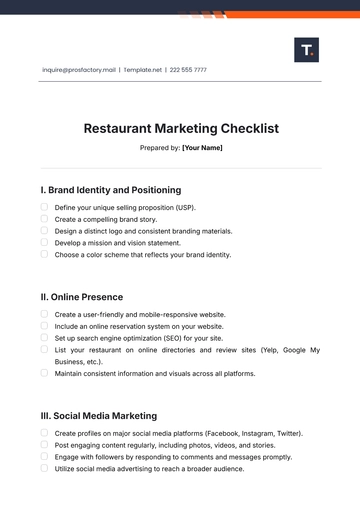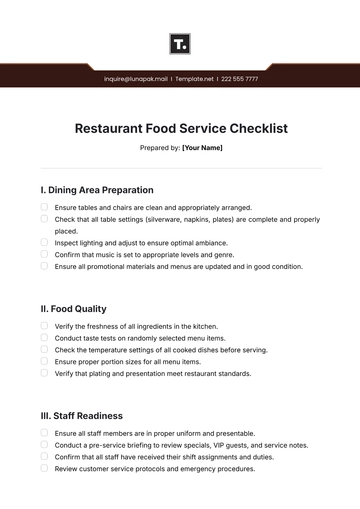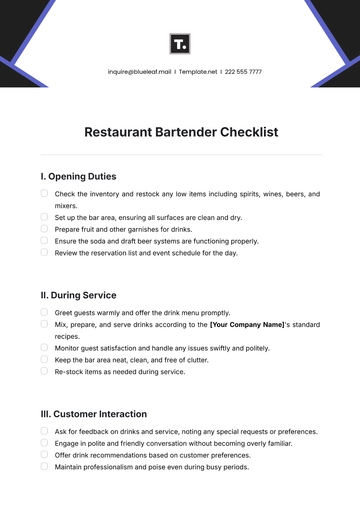Free Restaurant Hygiene Checklist

Name | Company | Address |
[Your Name] | [Your Company Name] | [Your Company Address] |
I. Personal Hygiene
Staff are properly attired in clean uniforms, hairnets, and appropriate personal protective equipment (PPE), such as gloves and aprons.
Employees practice good personal hygiene, including frequent handwashing with soap and warm water, especially after handling raw food, using the restroom, or touching their face or hair.
II. Food Storage and Handling
Raw food items are stored separately from cooked or ready-to-eat foods to prevent cross-contamination.
Perishable foods are stored at proper temperatures in refrigerators or freezers to maintain freshness and prevent spoilage.
Food containers are properly labeled with the date of preparation and expiration date to ensure proper rotation and minimize food waste.
III. Food Preparation Surfaces and Equipment
Food preparation surfaces, cutting boards, and kitchen equipment are cleaned and sanitized regularly to prevent the growth of bacteria and pathogens.
Kitchen utensils, knives, and cooking equipment are washed, rinsed, and sanitized after each use to prevent cross-contamination.
IV. Dishwashing and sanitation:
Dishwashing sinks and equipment are cleaned and sanitized regularly to ensure proper hygiene and prevent the spread of germs.
Dishwashing detergents and sanitizers are used according to manufacturer instructions and at appropriate concentrations.
V. Sanitation of Dining Areas:
Dining tables, chairs, and high-touch surfaces such as menus, condiment containers, and salt and pepper shakers are cleaned and sanitized between each seating or customer use.
Restrooms are cleaned and stocked with hand soap, paper towels, and toilet paper, and checked regularly for cleanliness and hygiene.
VI. Pest Control and Waste Management:
Regular pest control measures are implemented to prevent infestations of insects, rodents, or other pests.
Waste bins and garbage disposal areas are emptied and cleaned regularly to prevent odors and the attraction of pests.
VII. Water and Ice Safety
Ice machines and water dispensers are cleaned and sanitized regularly to prevent bacterial contamination.
Ice scoops are stored in a clean, dry location and not directly in contact with ice to prevent contamination.
VIII. Employee Training and Monitoring
Staff are trained on proper food handling, sanitation practices, and hygiene protocols.
Regular inspections and monitoring are conducted to ensure compliance with hygiene standards and identify areas for improvement.
- 100% Customizable, free editor
- Access 1 Million+ Templates, photo’s & graphics
- Download or share as a template
- Click and replace photos, graphics, text, backgrounds
- Resize, crop, AI write & more
- Access advanced editor
Restaurant Hygiene Checklist Template, exclusively offered by Template.net. This customizable, downloadable, and printable tool guarantees thorough assessments of cleanliness and sanitation practices. Effortlessly edit using our AI Editor Tool to tailor the checklist to your restaurant's specific hygiene requirements. Simplify your hygiene routines for a clean and safe dining environment, ensuring guest satisfaction and compliance with health regulations.
You may also like
- Cleaning Checklist
- Daily Checklist
- Travel Checklist
- Self Care Checklist
- Risk Assessment Checklist
- Onboarding Checklist
- Quality Checklist
- Compliance Checklist
- Audit Checklist
- Registry Checklist
- HR Checklist
- Restaurant Checklist
- Checklist Layout
- Creative Checklist
- Sales Checklist
- Construction Checklist
- Task Checklist
- Professional Checklist
- Hotel Checklist
- Employee Checklist
- Moving Checklist
- Marketing Checklist
- Accounting Checklist
- Camping Checklist
- Packing Checklist
- Real Estate Checklist
- Cleaning Checklist Service
- New Employee Checklist
- Food Checklist
- Home Inspection Checklist
- Advertising Checklist
- Event Checklist
- SEO Checklist
- Assessment Checklist
- Inspection Checklist
- Baby Registry Checklist
- Induction Checklist
- Employee Training Checklist
- Medical Checklist
- Safety Checklist
- Site Checklist
- Job Checklist
- Service Checklist
- Nanny Checklist
- Building Checklist
- Work Checklist
- Office Checklist
- Training Checklist
- Website Checklist
- IT and Software Checklist
- Performance Checklist
- Project Checklist
- Startup Checklist
- Education Checklist
- Home Checklist
- School Checklist
- Maintenance Checklist
- Planning Checklist
- Manager Checklist
- Wedding Checklist
- Vehicle Checklist
- Travel Agency Checklist
- Vehicle Inspection Checklist
- Interior Design Checklist
- Backpacking Checklist
- Business Checklist
- Legal Checklist
- Nursing Home Checklist
- Weekly Checklist
- Recruitment Checklist
- Salon Checklist
- Baby Checklist
- Equipment Checklist
- Trade Show Checklist
- Party Checklist
- Hospital Bag Checklist
- Evaluation Checklist
- Agency Checklist
- First Apartment Checklist
- Hiring Checklist
- Opening Checklist
- Small Business Checklist
- Rental Checklist
- College Dorm Checklist
- New Puppy Checklist
- University Checklist
- Building Maintenance Checklist
- Work From Home Checklist
- Student Checklist
- Application Checklist





























